Sustainable Hand Drying and Life-Cycle Assessment
Innovative product designs boost building life cycle
![]() Continuing Education
Continuing Education
Use the following learning objectives to focus your study while reading this month’s Continuing Education article.
Learning Objectives - After reading this article, you will be able to:
- Discuss the use of LCA for product comparison and selection, including restroom products.
- Explain how restroom hand-drying choices can have a significant environmental impact.
- Discuss trends in sustainability and energy efficiency and how they impact the environment, with attention to life-cycle impacts or ROI (or both).
- List related trends in sustainable building or occupant health that could influence the choice of hand-drying products.
Unitary systems and equipment tend to be relegated to the last-minute spec or punch list. In some cases, they are considered items left beholden to the operational preferences—or standards—of the owner or tenant. This has long been the case, but the trend is changing quickly. Behind the move toward greater architect control and influence over appliance choices is the adoption of life-cycle analysis or assessment (LCA) into sustainable building standards, and the benefits of return-on-investment (ROI) analysis for both building occupants and owners.
Of course, some equipment has a greater impact than others in the ROI and life cycle of a building. Packaged terminal air conditioners, often found in hotel or motel rooms, offer a typical example; these products may be used for years, and their energy-efficiency ratings indicate a real effect on operational costs. Yet another type of equipment that deserves renewed scrutiny today is an option in restroom equipment: the category of hand dryers. In some buildings, the hand dryer is left out and towel dispensers are selected, leaving the client a legacy (and open-ended tab) for bulk quantities of roll or folded paper.
In more buildings, however—from the London Eye and Los Angeles International Airport to the Time Warner Center in New York and in Costco stores around the United States—electric dryers are chosen. This choice is an important one because relying on consumables has a significant impact on sustainability and occupant health, says James Dyson, an inventor and entrepreneur known for his designs of vacuum cleaners, fans and hand dryers. “Paper towels—like vacuum bags—are from a bygone era. Technology has moved on,” he explains. “People want to dry their hands quickly, completely and without damaging the environment.”
 |
High-speed, hands-in dryers are an alternative to hands-under type dryers and paper or cotton towels. Life-cycle assessment (LCA) studies have been used to compare their relative performance for a variety of environmental benefits. Image and design study courtesy of Borgo7 |
This learning unit reviews the environmental and societal value of reviewing the restroom specification more carefully. It will show that the choice of hand-drying method can have a sizable impact on green building design and energy-efficient operations, as well as side benefits to public health, occupant comfort and efficient operations. Comparisons are also made between warm-air and high-speed hand dryers —including hands-under and hands-in designs —as well as between electric dryers and paper methods.
Increasingly, architects are making strong recommendations for clients on the choice of hand-drying equipment, says Marlyn Zucosky, IIDA, director of interior design for Princeton, N.J.-based architecture firm JZA+D. “For office buildings, we tend to recommend touchless, high-speed hand dryers, which are seen as convenient for users and also easy to maintain for the property manager,” says Zucosky, whose practice is heavy on tenant installations and workplace design. “They can also contribute to greener, cleaner building practices.”
On a global level, the impact of hand-drying selection could have a significant environmental impact in aggregate. According to estimates cited in Crain's,1 hand dryers are in place in about 10 percent of nonresidential restroom locations in the United States. Given that there are millions of commercial and institutional buildings, one can infer that millions of locations today are buying and disposing of bulk paper for restroom operations. “This is very different from Europe, where warm-air hand dryers are far more prevalent,” says Todd Clarke, director of specifications, Dyson Inc. “For U.S. buildings, a hand dryer may be a small part of a facility's footprint, but across the whole market it can have a very big impact.”
 |
The choice of hand-drying method can impact building waste reduction and disposal energy, including that for paper trash from restrooms. The LCA impacts of installed equipment and bulk consumables like paper and soap must also be considered. Images and design study courtesy of Dyson Inc. |
Industry Standards
Even in one building, the numbers are surprising. As an example, says Clarke, at a college if each student washes his or her hands once per day using two paper towels, over a 200-day school year the consumption of paper towels easily reaches into the millions. (If the student body is 4,000 undergraduates, the total use would be 4,000 x 2 towels x 200 days, or 1.6 million towels.)
For reasons of client preference and environmental prerogatives, architects are lending more attention today to hand-drying methods and product review.
The potential change in choice of restroom equipment must be reviewed against a backdrop of codes, standards and regulatory jurisdiction. Overall there is little focus by standard-setting groups on hand dryers. For example, a new or renovated building may achieve the U.S. Green Building Council's LEED® Platinum certification regardless of the choice of hand-drying method. In addition, there is no established benchmark for certification under LEED for New Construction (LEED-NC); for that reason, a reduction in waste may be good for sustainability but it will not necessarily be awarded points toward any certification level.
On the other hand, the choice of hand-drying method can have a valuable contribution to LEED's Energy & Atmosphere (EA) credits, including Prerequisite 2 – Minimum Energy Performance, as well as EA Credit 1 – Optimize Energy Performance, which is required for all buildings that are LEED certified. In addition, the choice of hand-drying solution can impact the LEED category of Materials & Resources (MR), including the MR Prerequisite 1 & 2, the credit for Sustainable Purchasing: Ongoing Consumables (MR Credits 1.1 - 1.3), and Solid Waste Management: Ongoing Consumables (MR Credits 7.1 – 7.2).
Last, there is a new credit category in upcoming versions of LEED for using products that have undergone a published LCA.
What's left out? Related benefits of waste reduction and disposal energy, including those for paper trash from restrooms. The LCA impacts of installed equipment and bulk consumables like paper and soap are omitted, too. Social sustainability measures, such as universal design, in the drying method selected. User comfort and acoustical issues, such as the noise of electrical equipment operations. Plus energy impacts, such as the comparative operations energy use by warm-air vs high-speed dryers. And much more.
In the public sector, there are few guidelines to help specifiers. Equipment in many buildings can have U.S. EPA Energy Star ratings, but not hand dryers. In 2010, the short-term project funding through the American Recovery and Reinvestment Act (ARRA) stated an official federal preference for procuring products verified to be at least 25 percent more energy efficient than typical or alternative specifications.
In addition, the health impacts of various hand-drying methods are poorly understood and often left to an architect's personal preferences—a weak way to extrapolate against the diverse user bases in university buildings, hospitals or a baseball stadium. One challenge is that Ann Arbor, Michigan-based standards organization NSF International, The Public Health and Safety Company (formerly known as the National Sanitation Foundation), provides only limited standards guidance for hand dryers. One valuable but narrow standard is the protocol NSF P335 – Hygienic Commercial Hand Dryers. (See “A Key Dryer Standard.”2)
Still, linking hand dryer performance to user effectiveness, energy efficiency, acoustical comfort, and even public health is left largely to the architect to determine.
For example, the amount of time it takes for the appliance to dry the user's hands has a useful NSF benchmark: If it takes less than 15 seconds using air filtered by high-efficiency particle arrestor (HEPA) media, the product may qualify to bear the NSF seal. Yet the definition of what “dry” means is inconveniently left open. So while some manufacturers agree that “dry” means a measure of 0.1 grams of water total remaining on the user's hands, which is used for the P335 Protocol, this is by no means a universal assumption—which can make some LCA studies hard to compare. (See sidebar on the next page.)
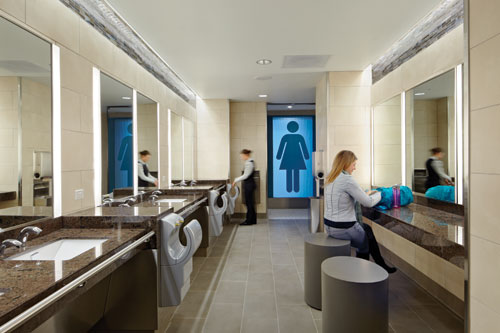 |
Ergonomics and user-friendliness are important considerations in restroom design, as is the usability of the hand-drying method by people in wheelchairs. Photo © Bruce Damonte |
Another challenge is that ergonomics and user-friendliness are not fully assessed by the protocol. In addition to speed of drying, the standard P335 considers the cleanability of the appliance, noise levels while operating, resistance to causing user burns, water disinfection capability, and whether or not the product allows for hands-free operation.
It's a good checklist, but it leaves out usability by people in wheelchairs, for example, or the discomfort associated with product use by seniors. With about 35 million U.S. citizens over aged 65 or over and with 54.5 million that have some disability, according to Boston's Institute for Human Centered Design (IHCD)—and with future LEED versions to include universal design such as the recent Pilot Credit 34, Design for Adaptability—the notion of user-friendliness has become central to green design as well as public Health, Safety and Welfare (HSW).
Most important, the protocol is all about hygiene. NSF P335 is not designed to present comparative data on using hand dryers—hygienic or not—over paper towels. Put simply, the protocol won't give a life-cycle argument for the environmental benefits of the selection.
LCA Studies for Hand Drying
“In the absence of comparable, full data informing our selection of a building material or appliance, we like to see thorough life-cycle assessments that help us and our clients understand any long-term environmental gains possible through our design choices,” says Jay Brotman, AIA, LEED AP, a partner with New Haven, Conn.-based architecture and art firm, Svigals + Partners. Fortunately, LCA studies have been undertaken for this product category—in the MasterFormat division 10 2000, Interior Specialties, under 10 28 40 for hand dryers as well as for alternatives including paper towel and cotton roll towels. However, the assessments start with different assumptions so architects can't easily compare the results apples-to-apples. Some LCA results only compare standard warm-air dryers to paper towels or one electric dryer type against another, while other studies only assessed cotton roll towels vs paper towels.
A number of the studies comply with an accepted standard for life-cycle assessments, such as the International Organization for Standardization's ISO 14040 and 14044 LCA standards, but most do not. Examples of those adhering to the ISO standards include an analysis of cloth and paper towels by a European textile trade group, a study of various folded and roll towel products for the paper producer Kimberly-Clark, and LCAs of multiple or single electric dryers by their respective manufacturers.
With all these life-cycle studies on the market, how can architects glean useful, equivalent data for making a good choice and specification?
One recent meta-study by a Boston-area research university has put all these LCA studies side by side, using ISO-based LCA methods to ensure a consistent basis of comparison. According to the authors of the mid-2011 analysis, titled Life-Cycle Assessment of Hand-Drying Systems,3 four steps were needed to compile and evaluate all of the industry data:
- Establish the “functional unit under consideration, and regional and temporal boundaries of the assessment.” In this case, the functional unit is a single pair of dry hands.
- Undertake an inventory analysis, which “entails the quantification of energy, water, and material resource requirements, and emissions to air, land, and water for all unit processes within the life cycle.”
- Assess impacts to understand “the human and ecological effects of the resource consumption and emissions to the environment associated with the life cycle.”
- Interpret the results “within the context of the limitations, uncertainty, and assumptions in the inventory data and scope.”
The research team at the Cambridge, Mass.-based Materials Systems Laboratory (MSL) recorded, interpreted and compared data for seven hand-drying systems: cotton roll towels; virgin content paper towels; 100 percent recycled paper towels; a typical warm-air, hands-under electric dryer; a high-speed, hands-under dryer; and two high-speed, hands-in dryers, one in a plastic finish and the other in an aluminum housing.
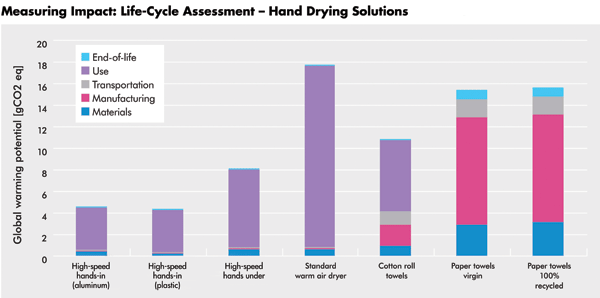 |
Cambridge, Mass.-based Materials Systems Laboratory has compared data for seven hand-drying systems. One of the comparisons is based on GWP, or global warming potential, based on CO2 equivalents required for each option. Source: Materials Systems Laboratory |
| Using LCA for Product Analysis |
Life-cycle assessment (LCA) is a scientific means for analyzing the environmental impact of a single building product or a group of functionally comparable alternatives. Various technologies with the same purpose can be directly compared, such as two complete cladding systems. The main benefit of LCA is that it considers whole product systems for a detailed and balanced comparison of their total environmental footprint. This means they must cover: constituent materials; manufacture and production methods; base material and product transport; use-phase properties; and disposal and reuse options. Assumptions in LCAs are made for particular situations and justified through clearly stated variables. These may include manufacturing location, product usage scenarios as well as recyclability of constituent materials or product components. Most important, an LCA must consider the environmental impact in a holistic way, reviewing everything from resource use and ecosystem quality to global warming potential (GWP) and potential human health impacts. GWP, expressed as CO2 equivalents, is a well-accepted metric that uses measured carbon dioxide equivalent totals to compare the environmental impacts of like products or materials. International standards are employed to help ensure that the LCAs are rigorous and comparable to others. Two of those, ISO 14040 and ISO 14044, have been created to standardize the functional units compared and the system boundaries for the product under consideration. To make direct comparisons between two dissimilar LCA studies, the architect or green building consultant must ensure that the justified functional unit and set of system boundaries are consistent among the LCAs across all potential scenarios. The LCAs should also provide for how changes to important variables might affect the overall outcome. |
Comparable LCA Data for Hand-Drying Systems
The results of the analysis have been the subject of some debate in an industry known for highly competitive and provocative claims. Yet most observers note that the study broke new ground, because the various LCA studies have never been compared against each other using rigorous statistical formulas.
In terms of green building design, the LCA analysis offers a cradle-to-grave analysis with all use-phase effects to understand the full, relative impacts of cloth, paper and electrical means. It includes all implied operational needs, including the dryer machine, towel dispensers, waste bins and bin liners, as well as packaging typically used. The impacts are allocated by assuming a five-year life span—mainly because electric dryers are typically warranted for five years—and a total life usage of 350,000 pairs of hands, or about 1,350 per week. In this way, the functional unit is defined as: 1/350,000, or 2.86 × 10-6 of the chosen drying method's total life-cycle impact.4
More assumptions need to be made to compare the drying methods. For example, trash or laundry bin liners—typically bags made of polyethylene or a biodegradable alternative material—can serve hundreds of pairs of hands but not all 350,000 uses. Bin liners for cotton rolls were set at 270 uses each, with 1/270 of a liner for each dry pair of hands; more are required for paper towels. On the other hand, cotton towels must be laundered, while paper towels do not have a washing impact.
In terms of transportation impact, the study assumes that all the drying systems are made in China and used in the United States, except for paper towels, which are primarily of domestic origin.
Upstream processes are also included in the analysis, say the authors. This is important, because the production of most dispensers and paper products is energy intensive. In one industry study,5 100 percent recycled paper towels are assumed to require about 40 percent of the embodied energy of virgin-source paper towels, estimated at 3.884 watts per paper towel. If two towels are used, the functional unit cost is 7.768 watts. Hand dryers, by comparison, may need only 2.9 watts total to produce a pair of dry hands—an energy savings of 63 percent over the five-year life of the systems.6 The use-phase assumption of two towels per dry—similar to the dry times for various electric dryers according to the NSF protocol P335—are important to an accurate estimate of the system LCA.
Impacts for the production phases, such as raw materials and manufacturing, seem to pale in comparison to the use-phase numbers over the five-year system lifetimes. In addition, the end-of-life scenarios are important but relatively minor. One key fact from an environmental standpoint is that recycling is uncommon for products used in America's 20 million away-from-home restrooms. “Since paper towels can use recycled content but are rarely recycled themselves,” write the MSL authors of Life-Cycle Assessment of Hand-Drying Systems, “they represent the final product of an open-loop recycling system.”
Yet by simply restating the disparate LCA data in terms of the functional unit, all of the impacts of hand-drying can be compared, allowing specifiers and building owners to make an informed and rigorous choice of restroom equipment.
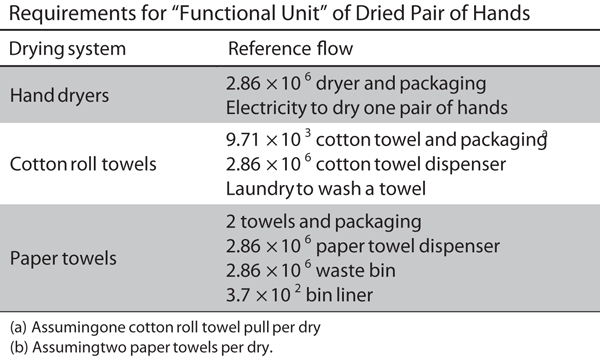 |
LCA studies have been compared side by side using ISO-based LCA methods to ensure a consistent basis of comparison. To compare the studies, they are analyzed to determine life-cycle impacts for a single “functional unit” – in this case, a single pair of dry hands.7 Source: Materials Systems Laboratory |
Addressing Real-World Uncertainty
The MSL analysis of various LCA studies for hand drying also includes a detailed sensitivity and uncertainty analysis, which helps reinforce confidence in stated LCA results. Commonly used for scientific experiments, an uncertainty analysis investigates variables used in observations and models to quantify the range of potential variance or ambiguity in the conclusions, according to Etienne de Rocquigny, author of Uncertainty in Industrial Practice (Wiley & Sons) and an assistant research director at Ecole Centrale Paris, an engineering school in France. For the LCA comparison, the uncertainty analysis helps describe how confidence in the results may be impacted by methodology or “confounding effects.”
This is contrasted with a sensitivity analysis, which employs statistical methods to show how a model—such as an LCA—may have uncertainties in output due to uncertainty in the model's input.
For MSL's hand dryer analysis, “the sensitivity analysis compares the GWP [global warming potential] results for all seven of the hand-drying systems under different scenarios. All the baseline assumptions are varied, one at a time, in order to test the robustness of the baseline scenario results and conclusions.”
In 86 percent of the scenarios explored, the high-speed, hands-in dryer machines were found to have the lowest GWP of all the high-speed types. Further, the GWP for hands-in, electric drying is lower than the GWP for all other drying systems considered in 98 percent of all scenarios—a very robust level of certainty. In addition, say the authors of Life-Cycle Assessment of Hand-Drying Systems, the differences in the GWP impacts are “statistically meaningful even when accounting for uncertainty in the data sets used to generate the results.”
In the GWP calculations chart above, the average (mean) assessed global warming potential is given shown by the purple bars; the standard deviation, or calculated range of uncertainty, is shown by a gray dimension line.
Arguments For and Against Paper
The MSL study offered a window into two valuable conclusions for specifiers and their clients: First, that the design of electric hand dryers leads carries impacts to the lifetime results for green building and, second, that paper towels carry high life-cycle impacts that could offset their appeal for other reasons.
“Paper towels,” reads the report, is one of “the two worst-performing types of hand-drying system in terms of environmental impact.” There are several reasons for this, but the study concludes that the majority of the impact comes from the production of the paper towels themselves.
Yet, paper towels are produced in a variety of ways, noted Slate.com environmental columnist Brendan Koerner in a recent industry overview.8 So how will architects know the typical impact for their project? There are variations in how trees are harvested and how much fossil fuel is required for cutting, transporting, pulping and processing of the raw materials. The use of recycled paper will reduce the energy needed by about 40 percent, according to the EPA. Also, the distances from the paper mill to the distribution points to end-users range widely.
Still, environmental groups such as the Climate Conservancy—a scientific nonprofit based in Palo Alto, Calif.—have estimated baseline figures for greenhouse-gas emissions to match the MSL's functional unit. Assuming two towels per session, the GWP cost is 0.123 pounds of CO2 equivalent per pair of dried hands.9 For hand dryers, for various wattages and drying times the Climate Conservancy estimated a range of 0.02 pounds to 0.088 pounds of greenhouse gas produced per pair of dried hands.
“The bottom line,” wrote Koerner, is that hand dryers will be the greener choice in about 95 percent of circumstances.” Yet the difference in energy used is markedly greater when paper-towel drying is compared to high-speed electric dryer technology. This is the second conclusion of the MSL study: that novel high-speed dryers offer substantially better life-cycle performance than standard warm-air dryers.
Standard warm-air dryers ranked last in the MSL review of LCA studies for GWP, with the highest environmental impact. They also had the worst impact in terms of human health and water consumption. For cumulative energy demand, they ranked second to last. High-speed dryers, on the other hand, were ranked first, second and third in all the LCA categories.
The main reason for the good LCA performance is the shorter drying time; for some product designs, the dryer motors do not have spin-down after use or a standby mode in between uses; both of these design features consume energy also.
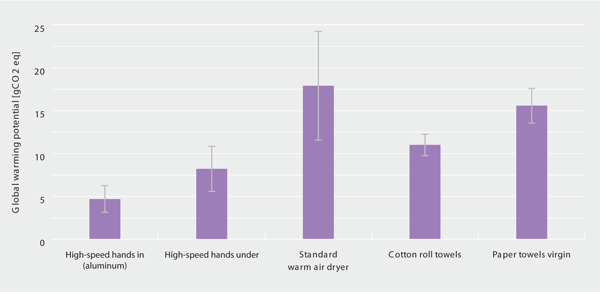 |
An LCA comparison has analyzed the differences in GWP impacts between various hand-drying methods. The grey dimension lines show the potential uncertainty in the calculations of GWP, given by the purple bars. Source: Materials Systems Laboratory |
Industrial Design and LCA
Through a single advance in the product design—the switch to high-speed airflow—the life-cycle impact of the restroom changes dramatically. This has been established for at least a decade, following an 2002 LCA study by Franklin Associates showing that recycled towels cost about 460 kilojoules per use—equivalent to one person exercising for about 20 minutes in a health club—while a standard (warm-air) hand dryer requires about 222 kilojoules per effective use.10 If the building occupant only uses one towel for drying, the two methods were shown to be essentially equivalent.
The high-speed dryer category shattered that potential equivalency, always performing best in the LCAs reviewed.
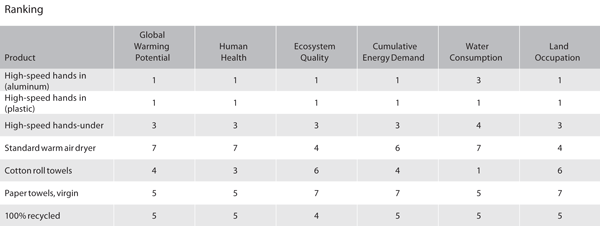 |
High-speed hand dryers were found to perform well in such categories as GWP, human health and cumulative energy demand. Source: Materials Systems Laboratory |
LCA studies and green building trends in general point up the importance of industrial design for sustainability. Every choice in the design of a high-speed dryer impacts its life-cycle attributes. For example, electric dryer housings are made of metal alloys, aluminum and plastics; the aluminum and metal versions, respectively, tend to the most and second-most energy intensive to manufacture.
But there's more: Both heat and airflow can contribute to water evaporation, and they are used in different ways by various dryer designs. Motor type, performance and spin-down affect how much energy the equipment uses for each restroom user. So does a choice pitting end-user convenience against system efficiency, such as automatic-off features or use of a standby mode rather than simple on-off switching. Form factor is another design variable, such as the orientation of the product and the shape of inlets for entraining air and propelling it to the point of contact at the user's hands. Some hand dryers allow for gravity to assist, for example. Last, there is a significant performance differentiation between standard carbon-brush motors and digital motors, which are found in some products.
The point is that products design is a general life-cycle indicator for building product specification, one that leads many architects to their choice or recommendation. “On our hospitality projects we have found that there is only one dryer type that actually works—the high-speed type—so we try only to spec that kind or recommend it to our clients,” says Joshua Zinder, AIA, LEED AP, NCARB, principal with JZA+D.
Last, there are important questions about public health, sustainability and the overall welfare of the end-user that could affect the ultimate product choice.
Health, IEQ and Comfort
| Hand Dryers and the ADA |
| A few general rules for hand dryers are worth considering in the early phases of product selection. Automatic dryers with no-touch operation are ideal, according to P.B. Gast & Sons, a janitorial and maintenance services provider in Grand Rapids, Michigan. Otherwise, start buttons should protrude from the dryer in a contrasting color. They should be operable with one hand and with no more than 5 pounds of force. For a restroom with a single dryer, the appliance should be 38 to 40 inches above the finished floor, with a minimum of 30 by 48 inches of clear floor space centered on the unit, so that wheelchairs can approach easily from both the left and right sides. For a restroom where two or more dryers are installed, one dryer should be installed so that the start button is 38 to 40 inches above the finished floor; others may be positioned at 41 to 48 inces. Again, alternate the layout for left-handed and right-handed wheelchair approaches.11 |
Of course, there's more to sustainability than life-cycle performance based on resources consumed, greenhouse gases emitted, and total energy draw. Several of these are referenced in the NSF standard P335, while others require scrutiny by the project team or client group. These considerations relate to IEQ (indoor environmental quality), such as acoustics and indoor-air quality, as well as building resources such as maintenance energy and occupant productivity and health. Key examples include:
Acoustics. Electric products make mechanical noise, of course, as opposed to a simple C-fold towel dispenser. The NSF P335 establishes a maximum decibel (dBA) rating, which some electric dryers meet. Are all high-speed air dryers noisier than conventional warm-air dryers? No, says a survey conducted by Acentech and published by the Acoustical Society of America. The report shows that some electric dryers have a dBA of about 84, well within the NSF protocol values. The reported that sound levels from other high-speed dryers are about 30 to 50 percent louder than the older models. Placing a user's hands within a high-speed air stream may create higher sound levels in some dryer models, with values varying between 95 dBA and 100 dBA. Special noise-reduction nozzles are available to cut noise up to about half, but those can increase the dry time by 2 or 3 seconds, changing their energy use and GWP.
ADA and adaptive, universal design. Restroom designs have changed fundamentally since the Americans with Disabilities Act (ADA) became law in 1990. Today, there is a movement to include more aspects of accessible and universal design into green building standards. The ADA was amended in 2008 and 2010 with important rules for hand dryers and towel dispensers; for example, ADA-compliant dryers may not protrude from the wall more than 4 inches. In general, mounting heights should present the device's operating features between 38 inches and 48 inches above the finished floor to allow forward reach by people in wheelchairs, where the nozzle is on the underside of the dryer. It's different for hands-in models: Hands-in type dryers must be installed with the bottom edge not higher than 27 inches off the ground to meet the ADA's cane detection requirement. As a side note, some designers and end-users have praised the hands-in dryers because they eliminate water being blown off hands and onto the wheelchair user.
| Tracking a Key Dryer Standard |
In 2007, NSF International developed a protocol that provides for evaluation and testing of commercial hand dryers. According to HIS Inc., the standard was developed to certify that commercial electric dryers actually dry the users’ hands hygienically. At the time, NSF sought to address the reasons behind the user preference for paper towels. The main reasons? About 70 percent said they take too long to dry hands, and about half said the appliances don’t dry hands Today, the protocol NSF P335 - Hygienic Commercial Hand Dryers, is seen as a useful public measure for the health and sanitary value of hand dryers. Among the primary definitions of “hygienic hand drying” are:
If the hand dryer meets these requirements, they qualify to have the circular NSF logo visible on the appliance body or nameplate. Later, NSF International announced compliant and certified dryers meeting NSF P335. The first company to be granted use of the NSF mark was Dyson Ltd., a U.K. manufacturer with a certified product.
|
User comfort and ergonomics. Beyond the prescriptive ADA rules, sustainable design values user comfort and good ergonomics as part of high-performance facility. With the 2009 version of LEED, the U.S. Green Building Council introduced a possible ergonomiccredit for existing and new work spaces through the Innovation in Design Process category. By definition, this should include restroom design considerations, as LEED extends the credit for “a comprehensive ergonomics strategy that will have a positive impact on human health and comfort when performing daily activity for at least 75 percent of Full Time Equivalent building users.”12
Personal hygiene and public health. Some studies have compared the hygiene benefits of drying methods on individual subjects or larger end-user populations. High-speed dryers using HEPA filtration are shown to capture at least 99.97 percent of bacteria from the air drying hands, which the NSF protocol uses to define “hygienic.” Studies by independent groups offer varied insights: One by the Bradford University Infection Group published in the Journal of Applied Microbiology concludes that microbial counts on hands decrease when dried properly, and that hands-in, high-speed dryers with HEPA filtration are the most hygienic electric types. Another study by the University of Westminster13 measured bacteria counts near and within about 6 feet of dryers and towel dispensers; electric dryers were shown to move bacteria longer distances. Related hygiene concerns include the issues of messiness from paper towels, both perceived (overflowing trash bins) and real (disease transmission due to user behaviors).
Maintenance and operations. Various considerations affecting the client's satisfaction with restroom performance also link to sustainability measures. Among the most important is energy use, which affects facility ROI as well as its meeting the Energy & Atmosphere (EA) credits for energy performance. In addition, the Materials & Resources (MR) credits reward the sensible purchasing of “ongoing consumables” (MR Credits 1.1 - 1.3) and proper waste management (MR Credits 7.1 – 7.2).
Beyond these impacts on building occupants listed here, there are more that depend on the user base and the objectives of the architect and client. The most important consideration may be that the restroom is full of environmental implications. One of the most important to consider is the choice of a hand dryer versus a paper towel dispenser. Others include day-to-day maintenance concerns, such as the frustrations faced by facility managers who see their low-flow toilets clogged by paper towels. By eliminating hard-to-flush paper, the buildings reduce water use better and solve such operational headaches.
Equipment seems to take the brunt of the concern, when the data clearly show that paper manufacture and waste can be the most environmentally damaging of any restroom challenge. Coverage in the media and information from manufacturers with a vested interest in the topic may not always provide adequate guidance. However a rigorous analysis of the existing data in recently published LCAs can help point to a better way to operate America's 20 million away-from-home restrooms.
 |
Dyson is about developing new technology and making things work better. Environmentally responsible engineering is efficient engineering. Doing more with less. Creating machines that consume less energy and are made of fewer raw materials, but are better performing. Their function-led approach to design supports this aim. www.dysonairblade.com |

 To maintain the certification, qualifying manufacturers must be audited and participate in product testing.
To maintain the certification, qualifying manufacturers must be audited and participate in product testing.